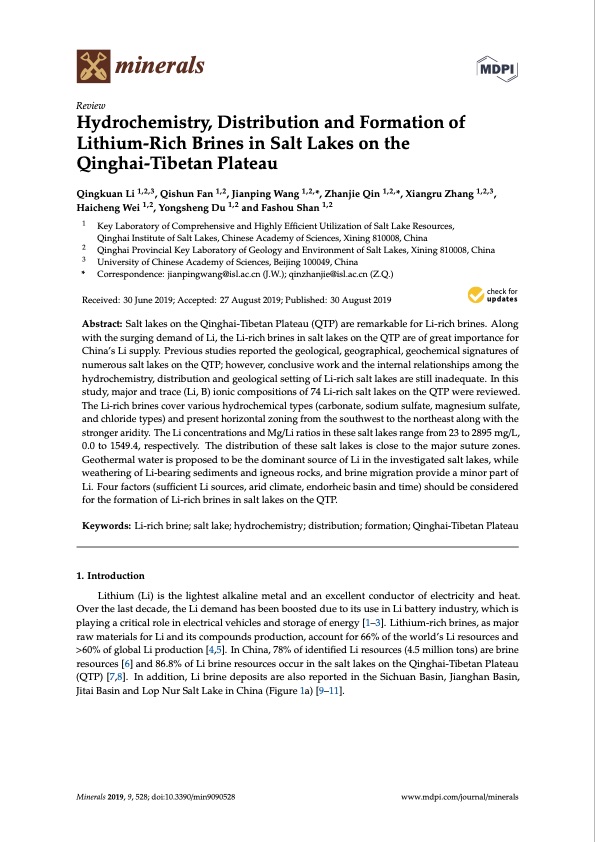
PDF Publication Title:
Text from PDF Page: 001
minerals Review Hydrochemistry, Distribution and Formation of Lithium-Rich Brines in Salt Lakes on the Qinghai-Tibetan Plateau Qingkuan Li 1,2,3, Qishun Fan 1,2, Jianping Wang 1,2,*, Zhanjie Qin 1,2,*, Xiangru Zhang 1,2,3, Haicheng Wei 1,2, Yongsheng Du 1,2 and Fashou Shan 1,2 1 2 3 * Correspondence: jianpingwang@isl.ac.cn (J.W.); qinzhanjie@isl.ac.cn (Z.Q.) Received: 30 June 2019; Accepted: 27 August 2019; Published: 30 August 2019 Key Laboratory of Comprehensive and Highly Efficient Utilization of Salt Lake Resources, Qinghai Institute of Salt Lakes, Chinese Academy of Sciences, Xining 810008, China Qinghai Provincial Key Laboratory of Geology and Environment of Salt Lakes, Xining 810008, China University of Chinese Academy of Sciences, Beijing 100049, China Abstract: Salt lakes on the Qinghai-Tibetan Plateau (QTP) are remarkable for Li-rich brines. Along with the surging demand of Li, the Li-rich brines in salt lakes on the QTP are of great importance for China’s Li supply. Previous studies reported the geological, geographical, geochemical signatures of numerous salt lakes on the QTP; however, conclusive work and the internal relationships among the hydrochemistry, distribution and geological setting of Li-rich salt lakes are still inadequate. In this study, major and trace (Li, B) ionic compositions of 74 Li-rich salt lakes on the QTP were reviewed. The Li-rich brines cover various hydrochemical types (carbonate, sodium sulfate, magnesium sulfate, and chloride types) and present horizontal zoning from the southwest to the northeast along with the stronger aridity. The Li concentrations and Mg/Li ratios in these salt lakes range from 23 to 2895 mg/L, 0.0 to 1549.4, respectively. The distribution of these salt lakes is close to the major suture zones. Geothermal water is proposed to be the dominant source of Li in the investigated salt lakes, while weathering of Li-bearing sediments and igneous rocks, and brine migration provide a minor part of Li. Four factors (sufficient Li sources, arid climate, endorheic basin and time) should be considered for the formation of Li-rich brines in salt lakes on the QTP. Keywords: Li-rich brine; salt lake; hydrochemistry; distribution; formation; Qinghai-Tibetan Plateau 1. Introduction Lithium (Li) is the lightest alkaline metal and an excellent conductor of electricity and heat. Over the last decade, the Li demand has been boosted due to its use in Li battery industry, which is playing a critical role in electrical vehicles and storage of energy [1–3]. Lithium-rich brines, as major raw materials for Li and its compounds production, account for 66% of the world’s Li resources and >60% of global Li production [4,5]. In China, 78% of identified Li resources (4.5 million tons) are brine resources [6] and 86.8% of Li brine resources occur in the salt lakes on the Qinghai-Tibetan Plateau (QTP) [7,8]. In addition, Li brine deposits are also reported in the Sichuan Basin, Jianghan Basin, Jitai Basin and Lop Nur Salt Lake in China (Figure 1a) [9–11]. Minerals 2019, 9, 528; doi:10.3390/min9090528 www.mdpi.com/journal/mineralsPDF Image | Lithium-Rich Brines in Salt Lakes on the Qinghai-Tibetan

PDF Search Title:
Lithium-Rich Brines in Salt Lakes on the Qinghai-TibetanOriginal File Name Searched:
minerals-09-00528.pdfDIY PDF Search: Google It | Yahoo | Bing
Product and Development Focus for Infinity Turbine
ORC Waste Heat Turbine and ORC System Build Plans: All turbine plans are $10,000 each. This allows you to build a system and then consider licensing for production after you have completed and tested a unit.Redox Flow Battery Technology: With the advent of the new USA tax credits for producing and selling batteries ($35/kW) we are focussing on a simple flow battery using shipping containers as the modular electrolyte storage units with tax credits up to $140,000 per system. Our main focus is on the salt battery. This battery can be used for both thermal and electrical storage applications. We call it the Cogeneration Battery or Cogen Battery. One project is converting salt (brine) based water conditioners to simultaneously produce power. In addition, there are many opportunities to extract Lithium from brine (salt lakes, groundwater, and producer water).Salt water or brine are huge sources for lithium. Most of the worlds lithium is acquired from a brine source. It's even in seawater in a low concentration. Brine is also a byproduct of huge powerplants, which can now use that as an electrolyte and a huge flow battery (which allows storage at the source).We welcome any business and equipment inquiries, as well as licensing our turbines for manufacturing.| CONTACT TEL: 608-238-6001 Email: greg@infinityturbine.com | RSS | AMP |